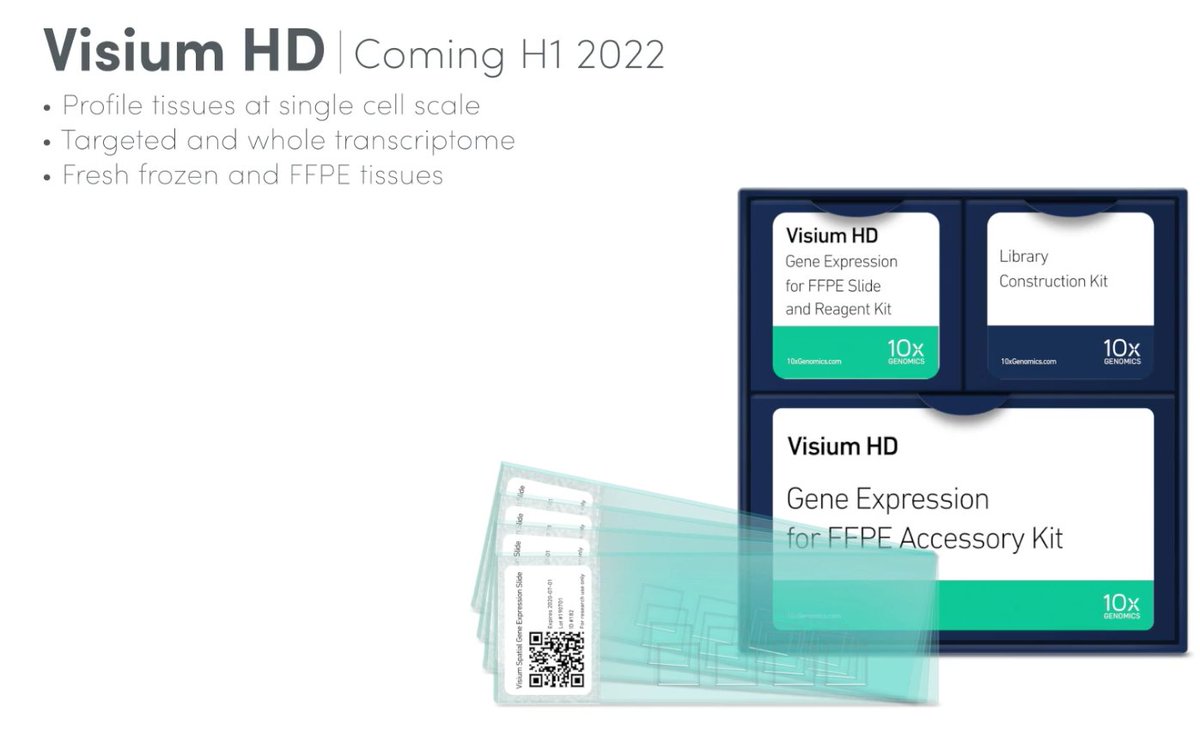My highlights of the @10xGenomics #Xperience2021 event. The list of products keeps growing, I would highlight Chromium Connect as an underappreciated tool to bring the products up another level of throughput. Important as with #NGS, it won't take long to go from n=1 to n=96+. 

#CellPlex species-agnostic multiplexing up to 12 samples: not dissimilar to products such as TotalSeq, but baked-in so that it's been tested to work with the rest of the workflow. 

Going close to 1M cells, the #ChromiumX brings about 100x fold throughput increase, all marked with 'HT' in the Kits. I'd be interesting to know how the different #BodyAtlas projects embrace this and for what. 



Now fixed RNA: I am not interested in this (much), but I can see the appeal: store the samples for a few days, make pooling (logistics) easier. 

Also, pharma companies have shelves upon shelves of tissue slices, so as long as 'old FFPE' works as well as 'recent FFPE', pharma will *love* this: 

Low-Throughput Gene Expression Kit (1/3 of the cost of standard throughput): very clever move by @10xGenomics, as adoption is always inversely proportional as the barrier to entry of a "failed experiment": can you afford a failed experiment to not dissuade you to try again? 

BEAM-T and BEAM-Ab: antigen-specificity, although it doesn't describe how is this done. For BEAM-T, it's based on Tetramer shop peptide synthesis system. 

BEAM-Ab exemplified for #COVID19 antigen-specificity of 5 different protein probes. This reads to me as "Libra-seq a-la 10X" but no details of the specifics in the presentation. 



#ChromiumConnect gets more preps available: 5' GEX and immune expression. Smaller prep variability, Hands-on-time, throughput. 



#Cloud Analysis: who doesn't love the cloud? As some of these analyses are IO heavy and CPU heavy, this facilitates analysis for people without the right infrastructure, but also it's provided *free* for every sample produced. 



Example of drug screening at different time points, bringing #CellPlex and #ChromiumX: a good way of telling people what kind of experiments they can imagine with these new tools: 96 conditions, 500k cells in 1 HT kit. 



The second half of the presentation is all about #spatialomics
The #SpatialTranscriptomics acquisition key to improvements by @10xGenomics in #spatialomics (James Chell talking from Stockholm). The #VisiumHD is the biggest announcement, but the FFPE RNA expression Visium is huge for clinical samples.
Good that they acknowledge that the longer the FFPE is in storage, the greater the degradation of the DNA/RNA material. New method starts with high sensitivity. 



FF vs FFPE correlation plots and pathology annotation correlations with the clustering performed by the #Visium software. Same for IHC. 







New configuration of the slides, with large capture areas (2 per slide), with the same resolution as the current ones. 

Now to the next trick: how to make compatible the samples that are already in slides, and need transferring to the #Visium slides? #CytAssist helps both previewing the tissue sections and select the ones to transfer to #Visium 







Loupe Browser Pathology Annotations: manually curated regions to match the pathology-derived reasoning, which then can be interactively turned into biomarkers. 





Now onto proteins: same tissue section, we can do mRNA, but also proteins: current product allows for a handful of proteins. Now highly multiplexed assay available: 10s of proteins (up to 100?) alongside mRNA. 

The same sample is thus utilized for mRNA and proteins: no approximations from before/after section.
#VisiumHD: 5um spot size. Images speak for themselves. FFPE compatible. Spots are also tightly packed, so single-cell scale is achieved. All that applies to #Visium does to #VisiumHD now. 





Finally, #ReadCoor and #Cartana acquisitions (Harvard and Stockholm tech, respectively): In Situ platform by @10xGenomics. Nikhil Rao presents. This is for orthogonal approach when you know what you are looking for. 

Hybridization of probe barcodes directly on tissue, multiple rounds of imaging. No need for #NGS, as it's image-based readout. Showing 1/2 of a mouse brain below, showing oligodendrocytes in blue, single-molecule marks. 



Combined usage is perceived by @10xGenomics as a great way of deeply studying biology. #singlecell sequencing for discovery, design a targetted panel for in situ, then apply to slides directly. 

Integrated hardware+software In situ solution coming soon, supporting FFPE and FF. Access program for now. 



A final remark on the company's segmenting of the market: from research to translational to clinical. They didn't say they want to offer clinical-grade products, but I guess if they could, they would?
All in all, as many have already commented on social media, a very rich presentation from @10xGenomics, which I feel compensates by the lack of oomph by any of the #NGS companies in #AGBT21 so far.
@D2Unroll unroll
• • •
Missing some Tweet in this thread? You can try to
force a refresh














